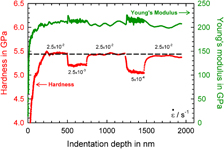Crossref Citations
This article has been cited by the following publications. This list is generated based on data provided by
Crossref.
Peykov, Daniel
Martin, Etienne
Chromik, Richard R.
Gauvin, Raynald
and
Trudeau, Michel
2012.
Evaluation of strain rate sensitivity by constant load nanoindentation.
Journal of Materials Science,
Vol. 47,
Issue. 20,
p.
7189.
Misra, R.D.K.
Zhang, Z.
Jia, Z.
Venkatsurya, P.K.C.
Somani, M.C.
and
Karjalainen, L.P.
2012.
Nanoscale deformation experiments on the strain rate sensitivity of phase reversion induced nanograined/ultrafine-grained austenitic stainless steels and comparison with the coarse-grained counterpart.
Materials Science and Engineering: A,
Vol. 548,
Issue. ,
p.
161.
Merle, Benoit
Maier, Verena
Göken, Mathias
and
Durst, Karsten
2012.
Experimental determination of the effective indenter shape and ε-factor for nanoindentation by continuously measuring the unloading stiffness.
Journal of Materials Research,
Vol. 27,
Issue. 1,
p.
214.
Jankowski, Alan F.
and
Ahmed, H.S. Tanvir
2012.
The nanoscratch hardness of a gold–nickel nanocrystalline nanolaminate at high strain rate.
Materials Letters,
Vol. 77,
Issue. ,
p.
103.
Maier, Verena
Hausöl, Tina
Schmidt, Christian W.
Böhm, Wolfgang
Nguyen, Hung
Merklein, Marion
Höppel, Heinz Werner
and
Göken, Mathias
2012.
Tailored Heat Treated Accumulative Roll Bonded Aluminum Blanks: Microstructure and Mechanical Behavior.
Metallurgical and Materials Transactions A,
Vol. 43,
Issue. 9,
p.
3097.
Merle, Benoit
Schweitzer, Elmar W.
and
Göken, Mathias
2012.
Thickness and grain size dependence of the strength of copper thin films as investigated with bulge tests and nanoindentations.
Philosophical Magazine,
Vol. 92,
Issue. 25-27,
p.
3172.
Wheeler, J.M.
Maier, V.
Durst, K.
Göken, M.
and
Michler, J.
2013.
Activation parameters for deformation of ultrafine-grained aluminium as determined by indentation strain rate jumps at elevated temperature.
Materials Science and Engineering: A,
Vol. 585,
Issue. ,
p.
108.
Maier, Verena
Merle, Benoit
Göken, Mathias
and
Durst, Karsten
2013.
An improved long-term nanoindentation creep testing approach for studying the local deformation processes in nanocrystalline metals at room and elevated temperatures.
Journal of Materials Research,
Vol. 28,
Issue. 9,
p.
1177.
Misra, R.D.K.
Venkatsurya, P.
Wu, K.M.
and
Karjalainen, L.P.
2013.
Ultrahigh strength martensite–austenite dual-phase steels with ultrafine structure: The response to indentation experiments.
Materials Science and Engineering: A,
Vol. 560,
Issue. ,
p.
693.
Kheradmand, Nousha
Vehoff, Horst
and
Barnoush, Afrooz
2013.
An insight into the role of the grain boundary in plastic deformation by means of a bicrystalline pillar compression test and atomistic simulation.
Acta Materialia,
Vol. 61,
Issue. 19,
p.
7454.
Guo, Y.Z.
Behm, N.A.
Ligda, J.P.
Li, Y.L.
Pan, Z.
Horita, Z.
and
Wei, Q.
2013.
Critical issues related to instrumented indentation on non-uniform materials: Application to niobium subjected to high pressure torsion.
Materials Science and Engineering: A,
Vol. 586,
Issue. ,
p.
149.
Rajaraman, S.
Jonnalagadda, Krishna N.
and
Ghosh, P.
2013.
Dynamic Behavior of Materials, Volume 1.
p.
157.
Wheeler, J.M.
Niederberger, C.
Tessarek, C.
Christiansen, S.
and
Michler, J.
2013.
Extraction of plasticity parameters of GaN with high temperature, in situ micro-compression.
International Journal of Plasticity,
Vol. 40,
Issue. ,
p.
140.
Sabirov, I.
Murashkin, M.Yu.
and
Valiev, R.Z.
2013.
Nanostructured aluminium alloys produced by severe plastic deformation: New horizons in development.
Materials Science and Engineering: A,
Vol. 560,
Issue. ,
p.
1.
Su, J.
Guo, W.
Meng, W.
and
Wang, J.
2013.
Plastic behavior and constitutive relations of DH-36 steel over a wide spectrum of strain rates and temperatures under tension.
Mechanics of Materials,
Vol. 65,
Issue. ,
p.
76.
Choi, In-Chul
Kim, Yong-Jae
Wang, Y. Morris
Ramamurty, Upadrasta
and
Jang, Jae-il
2013.
Nanoindentation behavior of nanotwinned Cu: Influence of indenter angle on hardness, strain rate sensitivity and activation volume.
Acta Materialia,
Vol. 61,
Issue. 19,
p.
7313.
Choi, In-Chul
Kim, Yong-Jae
Seok, Moo-Young
Yoo, Byung-Gil
Kim, Ju-Young
Wang, Yinmin
and
Jang, Jae-il
2013.
Nanoscale room temperature creep of nanocrystalline nickel pillars at low stresses.
International Journal of Plasticity,
Vol. 41,
Issue. ,
p.
53.
Haghshenas, M.
and
Klassen, R.J.
2013.
Assessment of the depth dependence of the indentation stress during constant strain rate nanoindentation of 70/30 brass.
Materials Science and Engineering: A,
Vol. 572,
Issue. ,
p.
91.
Guisbiers, G.
Colla, M.-S.
Coulombier, M.
Raskin, J.-P.
and
Pardoen, T.
2013.
Study of creep/relaxation mechanisms in thin freestanding nanocrystalline palladium films through the lab-on-chip technology.
Journal of Applied Physics,
Vol. 113,
Issue. 2,
Ladani, L.
Harvey, E.
Choudhury, S. F.
and
Taylor, C. R.
2013.
Effect of Varying Test Parameters on Elastic–plastic Properties Extracted by Nanoindentation Tests.
Experimental Mechanics,
Vol. 53,
Issue. 8,
p.
1299.





